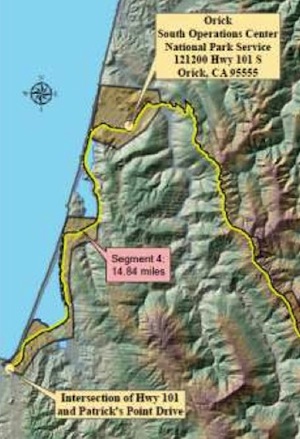
Section of coastal fiber route claimed by both KRRBI and NCC.
The Karuk and Yurok tribes on California’s far northern coast are asking for $6.6 million from the California Advanced Services Fund (CASF) to build an 82 mile fiber backbone to an existing Internet hub and then build out last mile wireless connections to 814 homes and businesses scattered across rugged inland terrain. A draft resolution released on Friday by California Public Utilities Commission staff recommends approving the money, which represents just over half of the total cost of the project.
The cost per premise directly served by the project is $8,100 to CASF and $15,700 total. On its face, it looks very high, but the draft resolution says it’s justified because of the middle mile benefits…
The cost per household is primarily driven by the middle mile segment that is required to deliver the last-mile fixed wireless service. Otherwise, without the costs of the middle-mile, the project cost per household is significantly less…
There is a very high probability that once this project is completed, the nearby Hoopa Tribe and community of Willow Creek will seek to connect to the middle mile network that this CASF project will build, to deploy fixed wireless broadband to more than 3,000 households in their communities.
If commissioners agree, they will be giving the tribes middle mile rights – at least as far as CASF subsidies are concerned – to a big area of Humboldt County. Which means that the 500 mile Humboldt and Del Norte Fiber project proposed by North County Communications, Inc. would be trimmed, if not completely trumped. In return, though, NCC or any other CASF-subsidised project would get preferential access. Dark fiber availability would be also guaranteed to any wholesaler…
[CPUC] staff has checked with the [Klamath River Rural Broadband Initiative] Project team to determine if it is building sufficient fiber strands and capacity is being built into the KRRBI middle-mile part of the project to ensure that the network is able to support future demand such as access to dark fiber to wholesale providers. The Karuk Tribe has confirmed that enough fiber and capacity will be built to support future demands. In its application, KRRBI states that two conduits will be placed in a ditch and a single, 72 strand fiber optic cable will be placed in one of these conduits. The unallocated fiber strands and the unused conduit space will allow for future expansion of the system without additional ground disturbance. The KRRBI middle mile network shall be made available for wholesale access to other potential CASF grantees at reasonable rates and terms. These reasonable rates shall be at cost.
One resolution regarding a specific project with particular circumstances doesn’t necessarily set a binding precedent for CASF-subsidised middle mile systems. Those terms were not imposed on Digital 395, for example. But it will frame the debate over other middle mile proposals, such as Golden Bear and Sunesys. It also raises the question of what’s meant by “wholesale provider”: would retail ISPs be locked out of dark fiber access and preferential rates?
Commissioners are scheduled to vote on the draft resolution at their 17 October 2013 meeting. In the meantime public comments, which often inspire changes in final resolutions, are being accepted.
